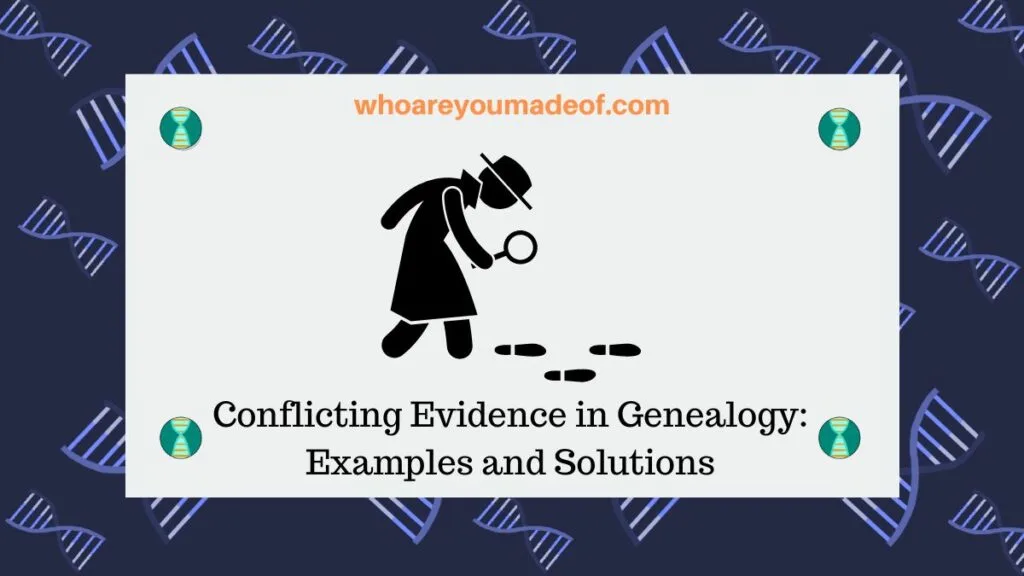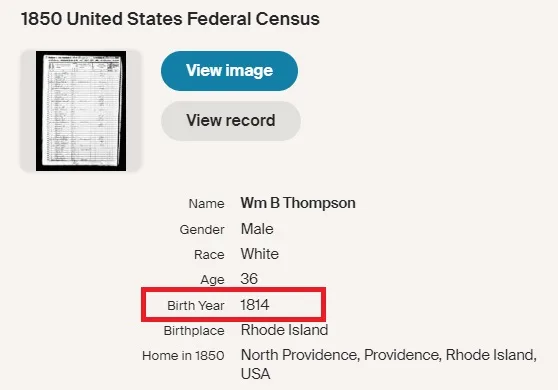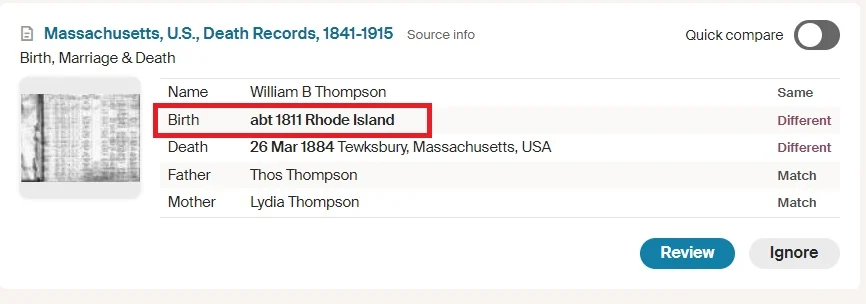What do you do when you find conflicting evidence in your genealogy research? In this post, find examples and solutions for how to proceed when the facts don't seem to match up with each other.

Conflicting evidence examples
The two most common situations when we see conflicting evidence in genealogy are when we see evidence that appears to be about our ancestor, but may not be, and when we have two records that we know correspond to our ancestor, but have different facts.
All types of evidence should be considered when it comes to researching our ancestors, so this includes many different types of genealogy records, family stories, and even oral histories. While we shouldn't fully depend on the family tree research of others, we can often use it as clues, and so some people might consider the work of others as evidence, too.
Evidence may not be relevant to the ancestor - example
One of the most common situations where we see contradictory evidence is when the record we are examining may not be relevant to our ancestor. If more than one aspect of the record doesn't seem to line up with what we already know about the person, the record may be about someone else.
As an example, I wanted to show a record for one of my 4th great-grandfathers, William B Thompson. In every single census record, he was listed as being born in Rhode Island, with an approximate birth date as either 1814 or 1815.

The discrepancy seen on estimated birth date for the US Federal Census for each decade between 1850-1880 is due to the date when he was asked his age. This discrepancy is easy enough to explain.
I had been stuck on this ancestor, and so I resorted to searching through a dozen or so public member trees on Ancestry to see if I could find a little detail that could point me in the right direction. Basically, I was just looking to see if anyone else had come up with origins for my Thompson ancestor.
Curiously, just about a dozen different researchers have determined that he died in Tewksbury, Massachusetts in 1884. On this death record, the William B Thompson is listed as having been born in Rhode Island in 1811.

There are two reasons why I am not ready to accept this record as being about my ancestor: the date of birth is a few years off (not just 1 or 2), and I have no evidence that my ancestor ever lived in Massachusetts. Every city directory, state and local census, as well as vital record, has my W. B. Thompson living in the same part of Rhode Island.
What's more, after his death, his widow lived with their daughter in Rhode Island. In essence, the record doesn't feel right to me, even though everyone else seems to have agreed on it - possibly because it's tempting to want to believe this records that lists his parents.
Two records show conflicting information
The second very common scenario is when we find two records that are definitely related to our ancestor, but they show different information. Different details can range from very minor, such as a spelling difference, to a major variation such as having a different parent listed.
There are many reasons why a detail could appear inconsistent between two records. Much of the time, it is due to the incomplete knowledge of the person providing the information to the record keeper.
For example:
- A discrepancy on a census form could be because the person who answered the door to the census taker didn't know the actual date of birth, so they estimated
- Place of birth of a parent not matching in between birth and death certificates could be because the parent provided the information himself when the child was born, but a more distant relative gave information for the death certificate
- An oral history (i.e. family interview) taken from a relative might have a memory of what they were told that doesn't match up with what you are finding in your research
It might surprise many to learn that vital records contain information that is incorrectly, usually by mistaken. Even my own birth certificate has my father's place of birth listed incorrectly, which I only learned a few years ago after requesting the long-form certificate from the state.
Accuracy is important in family tree research
We all know that it is important to be accurate in our family tree research. Every time a family tree is created or a family history is published with incorrect information, the real facts become harder to find.
When confronted with conflicting information, many family tree researchers are tempted to simply choose the fact that they like best, makes the most sense, or leads in a direction that is easiest to follow. What we should be looking for is the truth, and only that.
Whether the mistake was innocent, or a result of genealogy fraud, which shockingly is actually a thing, the consequences are for the rest of us are real. Those of us who do family tree research often invest hundreds of hours, and oftentimes even money, into learning about our ancestors.
So, what is a person to do when they find conflicting information? Sure, we can reach out to the person who published the incorrect information, such as the person who has a mistake in their tree, but how much does this really help?
How do you deal with conflicting evidence in genealogy
It can be frustrating to encounter genealogical evidence that doesn't match up with what you already know. Fortunately, there are steps that we can take to consider, process, analyze and interpret this conflicting information.
Have an open mind
The first thing that we must do when it comes to deciding what to do about conflicting data in genealogy records is to open our mind. When we have something that doesn't match up, we need to be open to all outcomes in order to figure out what is correct.
If we have a predetermined idea of what we are looking for, we could overlook something very important. When it comes to conflicting information, if we ignore it because it doesn't match up with what we were expecting, we might miss the chance to solve a mystery.
This is one reason why I am hesitant to completely rule out the Massachusetts death record that supposedly belongs to my Mr. Thompson, who I mentioned towards the beginning of this article. Could it be that I am letting my expectations keep me from considering this record?
Find more evidence
If we have two documents that don't match up, it makes sense that we should search for more items that can help us make our decision. Especially with our mind that has been newly-opened to considering any and all possibilities, we can now take to a search that could lead us to discover a new record that serves as a "tie breaker".
Since I had never considered that my Thompson ancestor had lived outside the state of Rhode Island, I could now look for evidence that he had. This is something that I had not really done prior, since I had assumed that he had always lived in the same town, so almost all of my searches are focused there.
In other words, I can look for proof that he did live in Massachusetts instead of trying to prove that he didn't.
Consider all evidence
Once we have gathered all possible evidence, which ideally includes much more than we started off with when we first found the discrepancy, we must consider it all. How do we do this fairly?
Evaluate the quality of all evidence
The way to fairly consider all evidence is to evaluate each record, document, photograph, story, or other evidence on its own merits. How reliable is each record as a source that we can trust?
While there are many factors that you can use to evaluate a record, just a few that I keep in mind are below:
- Were there different languages spoken between anyone involved in the record (from the record keeper to the person who the record was about)?
- Is there geographic knowledge that may have prevented the information from being accurately documented?
- Who provided the information to the record keeper?
- Are you reading a transcription or index or looking at the actual document?
- Were there witnesses to the event?
- Could your ancestor have had a motive to conceal or exaggerate a fact?
Once we have given objective thought to how reliable each source is, we will probably have a better idea as to how to resolve our discrepancy.
Consult the DNA
If you, or someone else related to the person you are researching, has taken a DNA test, you can use DNA evidence as an additional way to help resolve your discrepancy. Ethnicity estimates, and especially DNA matches, can help us make determinations about the accuracy of our family tree information.
For example, if you have two known descendants of a particular ancestor and they have both taken DNA tests, you can evaluate their total amount of shared DNA to see if it falls within the expected range.
DNA evidence is most compelling in relation to recent ancestors, but we can certainly use it at any point in our research along with traditional genealogy records.
Ask someone else's opinion
It is always a good idea to run your problems by a genealogy buddy. Sometimes it is easier for someone else to see where we have made leaps of logic and faulty assumptions.
Come back to the research later
Finally, don't be afraid to just put it down for now and come back later. Maybe you can spend some time working on another ancestor and come around to this one again in a few months.
Be sure to take notes on what you have learned and the questions you have left unanswered, since this will save you a lot of time when you pick things back up.
We all continuously learn about new genealogy methods and techniques through "on the job practice", if you will. For example, I know that I learn new things every week, and so I find myself coming back to an old problem with new ideas and solutions.
Conclusion
I hope that you have found this post interesting and helpful, and that you now have a few ideas about how to approach evidence that seems contradictory in your family tree research.
If you have any questions about something that you read in this post, or if you would like to share a story about a time you found conflicting facts, I would love to hear from you in the discussion below.
Thanks for stopping by today!
